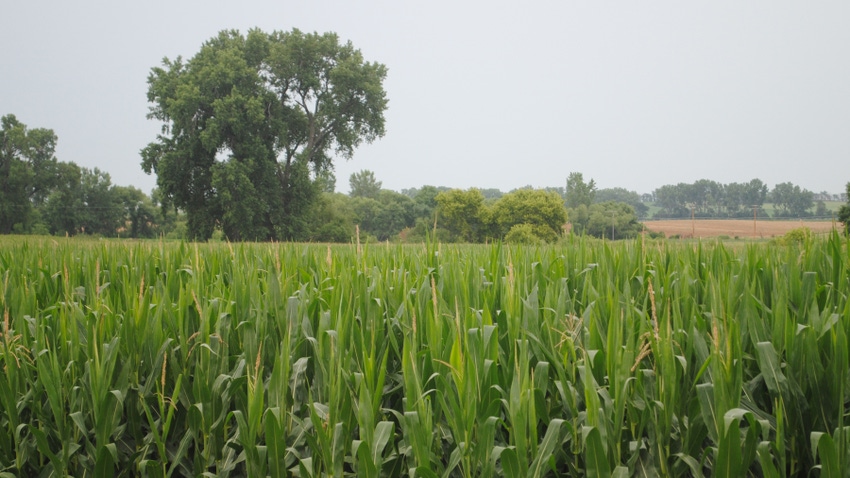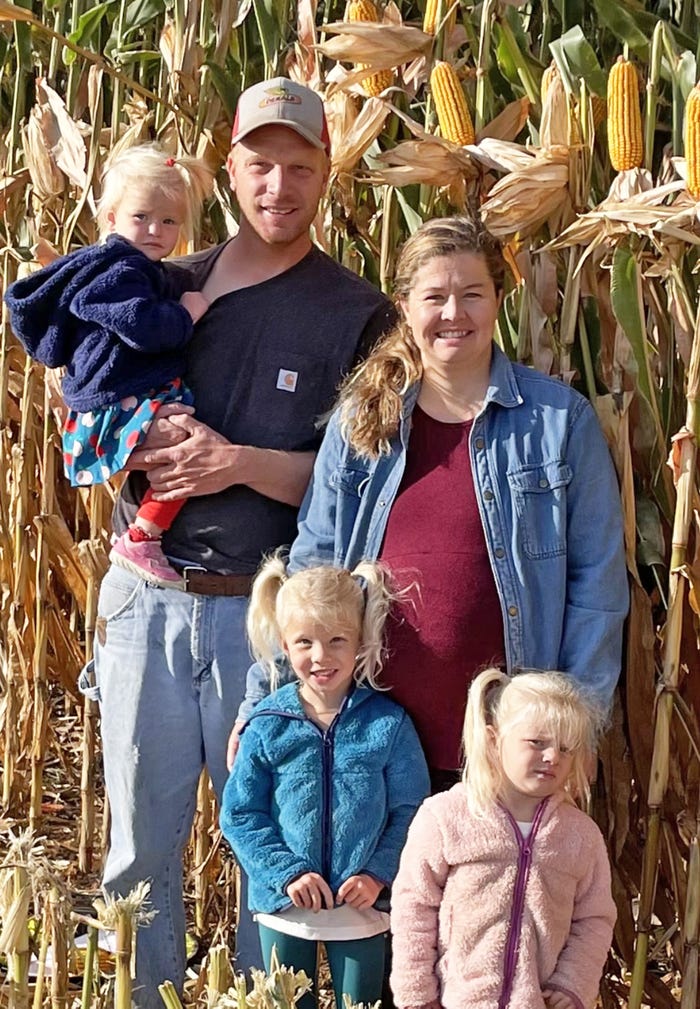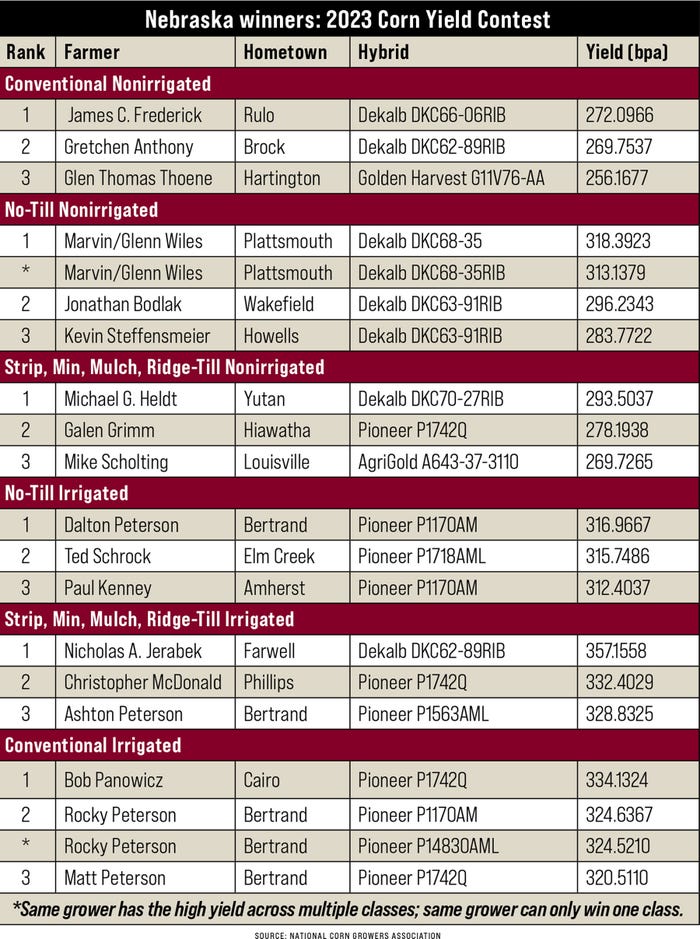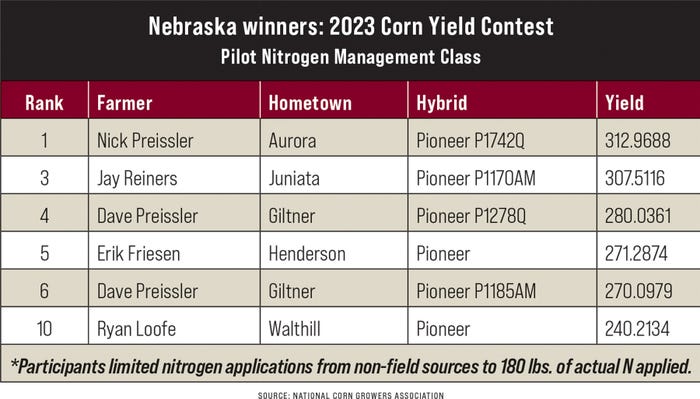
Nicholas Jerabek of Farwell, Neb., doesn’t have any secrets. But he shared some aspects of his cropping system strategies that may have put him over the top as a 2023 National Corn Yield Contest winner for Nebraska in the strip, minimum, mulch and ridge till irrigated division.
Jerabek planted Dekalb DKC62-89RIB and harvested 357.1558 bushels per acre.
Jerabek’s high-speed Valley center-pivot sprinkler allows him to apply as little as 0.04 inch of water per acre, making a circle in just three-and-a-half hours. While much of his crop ground is irrigated by gravity flow, the pivot allows him to spoon-feed his crops in-season.
“To me, that is one of the secrets of high yields,” Jerabek says. “We put that pivot up in 2021, and it really opens up our capability to foliar-feed the crop.”
Spoon-feeding
Jerabek can more efficiently chemigate with his pivot, applying nitrogen and sulfur in seven passes last year.
“Corn is designed to funnel water to the base,” he explains. “You get that with foliar feeding through the pivot and also applying fungicide without applying much water. We apply about four rounds of micronutrients, including boron, with the pivot.”
Jerabek farms with his father, Nick, raising corn on about two-thirds of their crop ground, with one-third in soybeans. They irrigate about 80% of their crops with water from nearby Sherman Reservoir in the Farwell Irrigation District. They are limited to 12 inches per year. In addition to crops, they own a small cow-calf herd.
“But my main enterprise, and you could say my passion, is growing corn,” Jerabek says. “We have pretty heavy soils here."
Previously, the family was no-till and ridge till, but four years ago they moved to strip till.
“Strip till works well, and makes a nice seedbed on the ridge,” Jerabek says. “It also takes the pressure off the planter as far as providing really ideal conditions to plant into, instead of rough no-till residue, cold, wet soils.”
Banding deep
Another key to high yields for Jerabek is deep banding. “We’re not surface-applying phosphorus,” he says. “We target phosphorus and zinc applications banded down into the ground, and that has led to better yields. We’ve really targeted banding all of our fertility between the strip till. We have to feed the plant right when it needs it and where it needs it. We sidedress with the cultivator, and we apply cattle manure to supply much of our macronutrients, where possible.”

FAMILY IN THE FIELD: Nicholas Jerabek holds his daughter, Caraline, and poses in the yield contest field last fall with his family — including his wife, Tess, and their other daughters Avery (in blue jacket) and Josie. Since the photo was taken, Tess gave birth to their son, Nash. (Photo by Nick Jerabek)
Planting 110– to 115-day maturity corn, Jerabek feels the optimal planting date for their farm is around May 1.
"We plant a lot of corn on corn, so there are challenges with diseases and insects like rootworm,” he says. “We plant treated seed corn and use insecticide. We address disease pressure with hybrid selection and one or two rounds of fungicides.
“I’m a little scared of tar spot,” Jerabek acknowledges. “With our irrigation, we are wetting the crop up to 15 times a year, so I have a feeling that when it comes around our part of Nebraska, with pivot irrigation, we are creating that damp, humid environment, which is a great breeding ground for diseases.”
Need ideal weather
As for the yield contest, generally in Nebraska, Platte Valley growers dominate the field. “They do everything right, but every once in a while, the weather will cooperate and you might get a win in the contest,” Jerabek says. “I’ve entered the yield contest for nine years, and this is the first year everything has come together.”
For Jerabek, last season started out with challenges. “The worst of the drought was southeast of us, but it was dry here too,” he says. “We strip-tilled in the fall and we had little moisture in the winter. Sherman dam doesn’t deliver irrigation water until June 1, so we had no way of watering.”
Jerabek plants corn with a John Deere 1720 planter set for 30-inch rows.
“We planted at a depth of 2½ inches to get to the moisture, but we still had seed sitting in dry dirt. It was the driest conditions I’ve ever planted in,” Jerabek says. “Three days after planting, we started to receive rain. If that had waited another week, our crop would have been a trainwreck. The rain saved it.”
This past fall and winter, going into the planting season of 2024 looks much improved from a moisture standpoint, he adds.
See the accompanying tables for more Nebraska yield contest winners.


Harvesttime tricks
“Dad runs the combine,” Jerabek says. “We’re not huge farmers. We focus on doing the best with the equipment we have.”
For high-yield corn, the key for Jerabek is harvesting early. “We have a feedyard nearby that we haul wet corn to during harvest,” he says. “We are harvesting corn that has moisture at 23% to 26%. That is our highest-yielding corn.”
They’ve been harvesting wet corn for 14 years. “As soon as the corn is black-layered, we have less header loss and less downed corn, and you can avoid some of that ‘phantom yield loss,’” Jerabek adds. “After maturing, you may lose yield. It is a pain, because we are balancing soybean harvest and wet corn harvest, but harvesting early means we get twice as much done in a day because the days are longer, and everything seems to work better.”
About the Author(s)
You May Also Like






